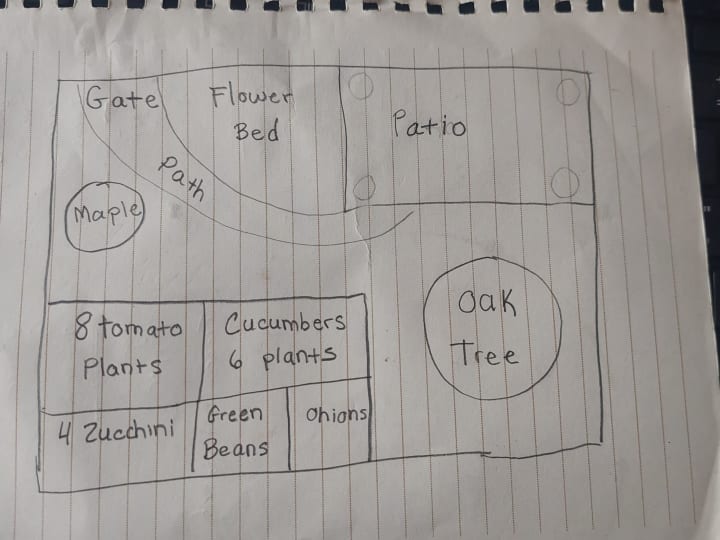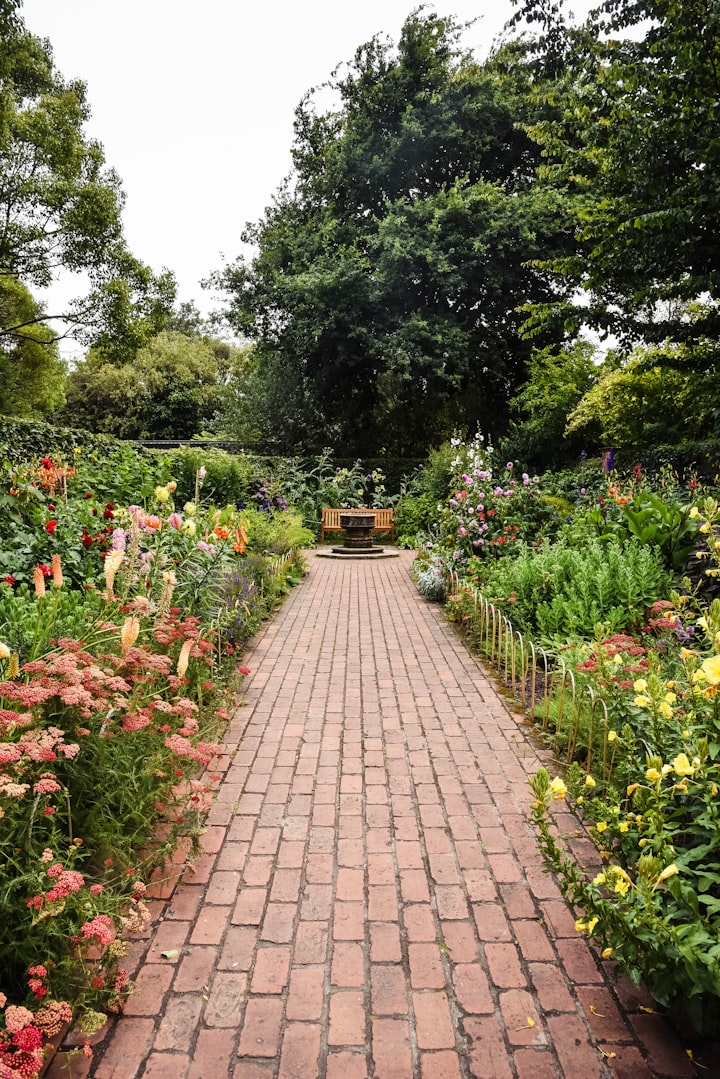Backyard Gardening 101: Where to Begin?
The Journey Begins!
Hello wonderful Vocal readers and writers! I recently joined Medium where I am working on crafting a new, high-quality page all about backyard homesteading! I don't want anyone to think I'm leaving Vocal!
Vocal's community is the most encouraging writing community! But I want to start focusing my writing. WordPress is where I'll put my travel content (you can find my website here!) and Medium will be all about gardening, vegetables, and homesteading (you can find my Medium page here!).
Vocal will continue to be my main place for publishing poetry, fantasy, and historical fiction! Think of it as my creative outlet! I just wanted to share my very first Medium article for my page on backyard homesteading! I won't be putting my content here regularly, but I am very excited for this endeavor and would really appreciate the love and support!
I'll continue to help you all grow in anyway I can!
Lots of love, as always!
Hello, dear readers! This is the very first installment in an ongoing series about backyard homesteading in the suburbs! We’ll begin with some basic, source documents to get you going with your backyard homestead!
Stay tuned, though! This Medium page is meant to be an interactive group where we’ll discuss raising animals and plants in the heart of Jersey. We’ll get a little personal about our experience and help you every step of the way!
Whether you’re a seasoned gardener, an intermediate, or brand new seedling, you’ll find what you need on our site! Please feel free to comment with any questions or suggestions you have at the end of this article or other future articles. We will respond within 2–3 days.
We’re excited to get started, and thank you for joining us!

What Is a Backyard Garden?
Backyard gardening involves planting vegetables, flowers, and other plants in your yard. Some people don’t have a backyard, so they may utilize the side and front of their homes to grow their crops and other vegetation. The purpose of such a garden is to relieve stress, purify the air, provide supplemental food, and more.
There’s no such thing as a right or wrong way of backyard gardening. Although, understanding how and why people do it can help you achieve success in your endeavors.
As mentioned above, some people don’t have a backyard. Just because you don’t have a backyard doesn’t mean you can’t use whatever you do have at your home! You can use the sides of your house, the front yard, and even a balcony if you don’t have a yard at all.
The goals of the garden are far more important than the technical definition.
Most people start their garden for the following reasons:
- Therapeutic reasons
- Improves air quality
- Avoid pesticides
- Grow organic food
- Save money
Don’t worry if your reason isn’t listed above. These are just a few of the reasons people start their backyard garden: all reasons are valid.
My mother originally started our garden to save money on groceries. We later started utilizing the side of the house and front yard to expand our production capabilities. My mother also told us she liked having gardens to keep us busy and teach us a good work ethic.
So far, I think it worked!
How Do You Start a Backyard Garden?
To begin your backyard garden, lay out a vision of what you hope to achieve. Evaluate your resources, such as money and how much space you have available for the garden. Finally, get the necessary supplies and seeds to achieve your goals.
Backyard gardening doesn’t have to be complicated. Rather, it can be a pleasant and straightforward experience! But that doesn’t mean it won’t require any preparation or effort.
Setting up your garden requires four basic steps: establishing a plan/goal, choosing a spot, preparing the soil, and choosing your plants of choice. We’ll go over these steps in detail below!
1. Establishing Your Goal
What are your hopes for gardening? Do you want to improve your mental health and lower stress levels? Or do you want to lower your grocery bill and avoid dangerous pesticides?
Try journaling about your goals or aspirations and see where your mind takes you. The more in-tune you are with your ambitions, the more clarity you’ll feel when starting your project.
2. Choosing a Spot
Establishing your goals or laying out a plan might not sound very exciting, but it will make a big difference once your garden is planted. When plotting our gardens at home, we draw out the game plan to start. We make a rough map of our backyard and establish which garden beds we wish to use for which vegetables.
Go outside and check out your yard. How much space do you have? Is there plenty of sunshine or a lot of shade? The types of vegetables and plants you can grow will be determined by how much sunshine your yard gets.
We’ll be doing an article about what plants you can grow in the shade versus direct sunlight. Once it’s finished, I’ll link it here! But basically, make a simple map of your yard. If you already have flower beds, label them with what you wish to grow where. Although, if you don’t have beds yet, establish a layout of where you want to set up your garden!

3. Choosing Your Plants
Next, let’s determine if your backyard has plenty of sunshine to grow sun-loving plants. If you have many trees and shade, don’t worry; there are plenty of flowers and shrubs you can grow.
However, if you want to grow plants like tomatoes, cucumbers, zucchini, and other popular vegetables, you’ll need spaces in direct or indirect sunlight. Most gardening experts say tomatoes, cucumbers, zucchini, and other sun-loving plants must get sunshine for at least 6 hours daily. Ideally, they should receive 8–10 hours of sunlight.
If you want to grow vegetables but don’t have any ideal locations, there are several ways to achieve your goal. First, you can speak to your local greenhouse owner or tree service about potentially cutting down a few trees or removing several large branches.
If you don’t want to remove trees, consider indoor gardening using artificial lighting. Although, unless you only want a small setup, this can be very complicated for a beginner. You’ll need a greenhouse, artificial lighting in the greenhouse, and a heat source. If you want to pursue this, I recommend using solar power if possible because the constant lighting will bump up your electric bill considerably.
Finally, you can also rent a plot in most towns that you can use to grow your own plants. Sometimes these plots are tiny and rather expensive, so maybe try shopping around and weighing your options.
As you can see, the types of crops you grow depend on the available sunlight. However, if you have plenty of sunshine and shade, your yard is perfectly designed for all kinds of plants. We’ll go into greater detail about what to grow where in another piece that’s coming soon!

4. Preparing Your Soil and Planting
Preparing your soil and getting your plants into the dirt is the final preparation step. There are several types of soils gardeners should be aware of when planning their gardens. These soil types include sandy, silt, loam, peat moss, and clay. Of course, this isn’t an exclusive list, but these are the primary types of soil you’ll find in gardens.
As a rule of thumb, loamy soil is the best. Loam comprises decayed and decaying organic materials that feed the soil and the plants. It’s also not heavy like clay soil which can choke the plant’s roots and cause decay.
Sand and silt soils are not great for growing most plants (although there are a few exceptions, like blueberries). Sand and silt tend to be low in minerals and decaying organic matter, making the soil richer and thus helping your plants grow big and beautiful. Sand and silt are also not great at retaining water, meaning you’ll waste a lot of water keeping your plants hydrated.
Several ways to improve your soil include adding compost, topsoil, and peat moss. Ideally, buy topsoil in bulk from your local garden center or landscaping company since it will likely be high-quality and cheaper than buying it by bag.
Finally, plant your crops! This step is the easiest since you already plotted your garden beds and prepared your soil. Remove the tiny leaves at the bottom of your seedling's stock if you're using seedlings rather than seeds. These are called suckers because they usually have bacteria and suck away the plant’s energy. Also, remove any flowers so the plant can grow bigger before wasting energy making flowers and vegetables.
Why Does Backyard Gardening Matter?
Backyard gardening is excellent for the environment, supports sustainable food sourcing, avoids excessive chemical runoff, and improves well-being. Starting your backyard garden is one of the best ways to heal your mind and body since it connects you to the Earth and makes you feel like you belong. Backyard gardening matters for you personally, your neighborhood, and the world as a whole.
Gardens influence us emotionally and physically. Being around beauty helps us relax, connect with the world, and feel like we’re part of something bigger than ourselves.
Your backyard garden can also help your neighborhood. I remember we grew surpluses of vegetables several years in a row and provided fresh vegetables to our community. People could get fresh, organic vegetables for way cheaper than the grocery store. They told us the veggies taste better and make them feel alive!
Trust me when I say this is one of the most fulfilling feelings you’ll ever experience!
Final Thoughts: Get Your Hands Dirty
We’re often afraid of “dirty things.” We see dirt, and we think it's gross and full of germs. And it is full of bacteria and organic enzymes that make the soil alive!
The Earth is a living organism, including the soil we grow our crops. The Greeks were right to call this planet Gaia, the great mother, because it is alive and teaming with all kinds of life! We need to tame our urges to kill everything around us because we’re afraid it might hurt us.
Respect it because, of course, nature can hurt you. But generally speaking, the Earth doesn’t want to hurt you. You are one of its many children, and when we destroy the bacteria and enzymes in the soil, we eliminate the planet’s ability to feed its children.
Go get your hands dirty! We’ll be here to help you every step of the way! Please check back every Monday, Wednesday, Friday, and Saturday for fresh and new pieces to help your garden grow!

About the Creator
Emily Marie Concannon
I am a world nomad with a passion for vegan food, history, coffee, and equality.
You can find my first novel on Kindle Vella here: https://www.amazon.com/kindle-vella/story/B09V4S7T4N :) I appreciate all your support and engagement! :)







Comments (2)
Wonderfully written and I Believe Gardening could be Therapeutic 🫶🏾📝😊
I've done some of this in the past, but live in a community where gardening is restricted. One thing I didn't see was how to keep the rabbits, squirrels, and other critters from enjoying your bounty before you do.